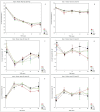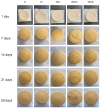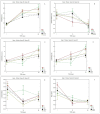Sheep's Second Cheese Whey Edible Coatings with Oregano and Clary Sage Essential Oils Used as Sustainable Packaging Material in Cheese
- PMID: 38472787
- PMCID: PMC10931019
- DOI: 10.3390/foods13050674
Sheep's Second Cheese Whey Edible Coatings with Oregano and Clary Sage Essential Oils Used as Sustainable Packaging Material in Cheese
Abstract
Sheep's second cheese whey (SCW), the by-product resulting from whey cheese production, was used as a component of cheese coatings containing oregano (Origanum compactum) and clary sage (Salvia sclarea) essential oils (EOs). SCW powder was obtained by the ultrafiltration/diafiltration of SCW followed by reverse osmosis and freeze drying. The coatings were produced with a mixture of SCW and whey protein isolate (WPI) using glycerol as plasticizer. Model cheeses were produced with cow´s milk and those containing SCW:WPI coatings; those with and without EOs were compared to controls without coating and with a commercial coating containing natamycin. At the end of ripening (28 days), the cheeses containing EOs presented higher water activity (ca. 0.930) and moisture content, as well as lower titratable acidity. Concerning color parameters, significant differences were also observed between products and as a result of ripening time. However, the use of SCW:WPI coatings did not significantly influence the color parameters at the end of ripening. Regarding texture parameters, the cheeses containing SCW:WPI coatings presented significantly lower values for hardness, chewiness, and gumminess. Significant differences were also observed for all microbial groups evaluated either between products and as a result of ripening time. In all cases, lactobacilli and lactococci counts surpassed log 7-8 CFU/g, while the counts of yeasts and molds increased steadily from ca. log 3 to log 6 CFU/g. The lowest counts of yeasts and molds were observed in the samples containing natamycin, but nonsignificant differences between products were observed. In conclusion, SCW:WPI cheese coatings can successfully substitute commercial coatings with the advantage of being edible packaging materials manufactured with by-products.
Keywords: cheese; edible coatings; essential oils; oregano; salvia; second cheese whey.
Conflict of interest statement
The authors declare no conflicts of interest.
Figures






Similar articles
-
Effect of Sheep's Whey Edible Coatings with a Bioprotective Culture, Kombucha Tea or Oregano Essential Oil on Cheese Characteristics.Foods. 2024 Dec 20;13(24):4132. doi: 10.3390/foods13244132. Foods. 2024. PMID: 39767074 Free PMC article.
-
Evaluation of the Characteristics of Sheep's and Goat's Ice Cream, Produced with UF Concentrated Second Cheese Whey and Different Starter Cultures.Foods. 2022 Dec 17;11(24):4091. doi: 10.3390/foods11244091. Foods. 2022. PMID: 36553833 Free PMC article.
-
Evaluation of antimicrobial edible coatings from a whey protein isolate base to improve the shelf life of cheese.J Dairy Sci. 2012 Nov;95(11):6282-92. doi: 10.3168/jds.2012-5478. Epub 2012 Aug 29. J Dairy Sci. 2012. PMID: 22939797
-
Valorization of cheese whey using microbial fermentations.Appl Microbiol Biotechnol. 2020 Apr;104(7):2749-2764. doi: 10.1007/s00253-020-10408-2. Epub 2020 Feb 3. Appl Microbiol Biotechnol. 2020. PMID: 32009200 Review.
-
Dairy By-Products: A Review on the Valorization of Whey and Second Cheese Whey.Foods. 2021 May 12;10(5):1067. doi: 10.3390/foods10051067. Foods. 2021. PMID: 34066033 Free PMC article. Review.
Cited by
-
Effect of Sheep's Whey Edible Coatings with a Bioprotective Culture, Kombucha Tea or Oregano Essential Oil on Cheese Characteristics.Foods. 2024 Dec 20;13(24):4132. doi: 10.3390/foods13244132. Foods. 2024. PMID: 39767074 Free PMC article.
-
A Review of Recent Developments in Edible Films and Coatings-Focus on Whey-Based Materials.Foods. 2024 Aug 22;13(16):2638. doi: 10.3390/foods13162638. Foods. 2024. PMID: 39200565 Free PMC article. Review.
-
Natural Polymer-Based Coatings for Animal-Derived Products: A Review of Applications, Functionality, Characterization, and Challenges.Foods. 2025 Jun 26;14(13):2255. doi: 10.3390/foods14132255. Foods. 2025. PMID: 40647007 Free PMC article. Review.
References
-
- Madureira A., Pereira C., Truszkowska K., Gomes A., Pintado M., Malcata F. Survival of probiotic bacteria in a whey cheese vector submitted to environmental conditions prevailing in the gastrointestinal tract. Int. Dairy J. 2005;15:921–927. doi: 10.1016/j.idairyj.2004.08.025. - DOI
LinkOut - more resources
Full Text Sources

